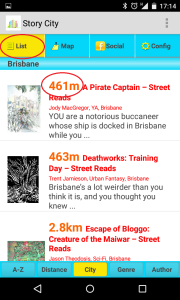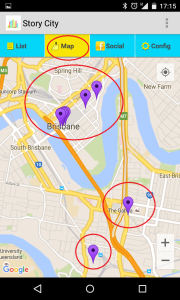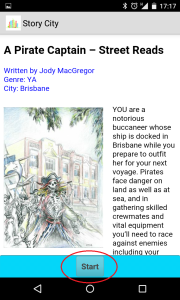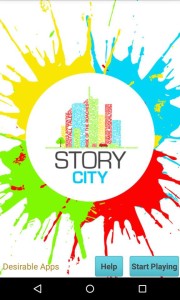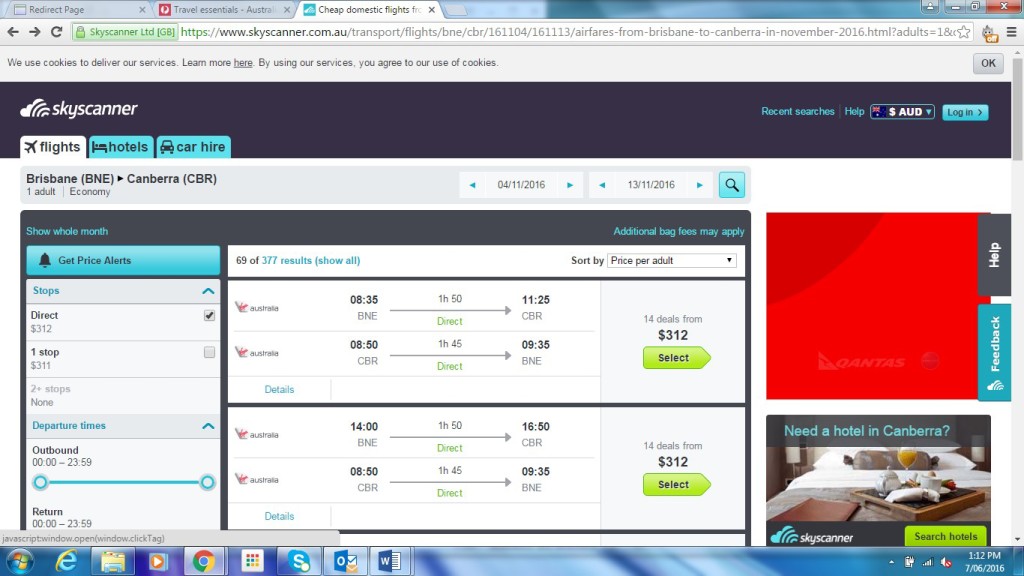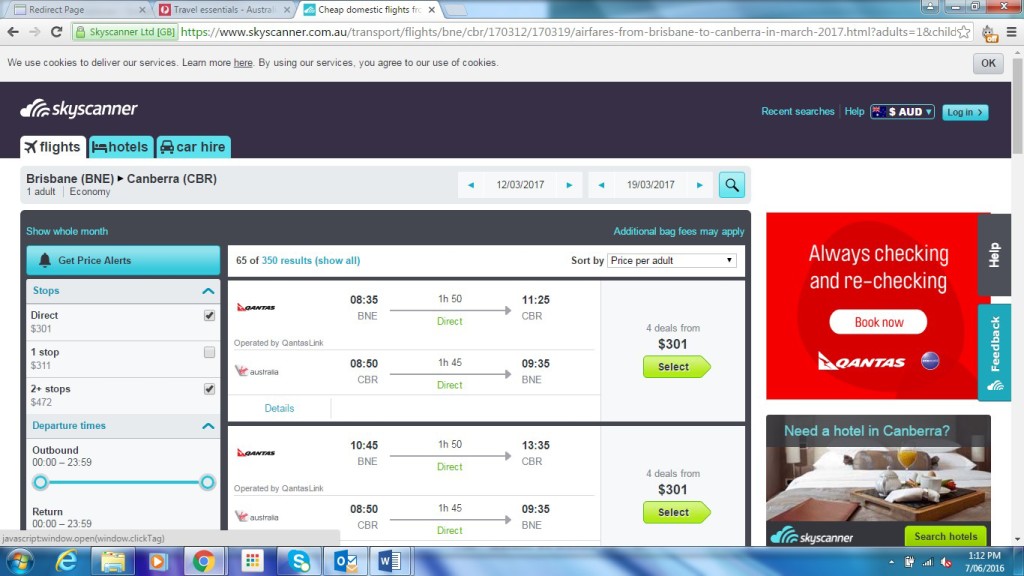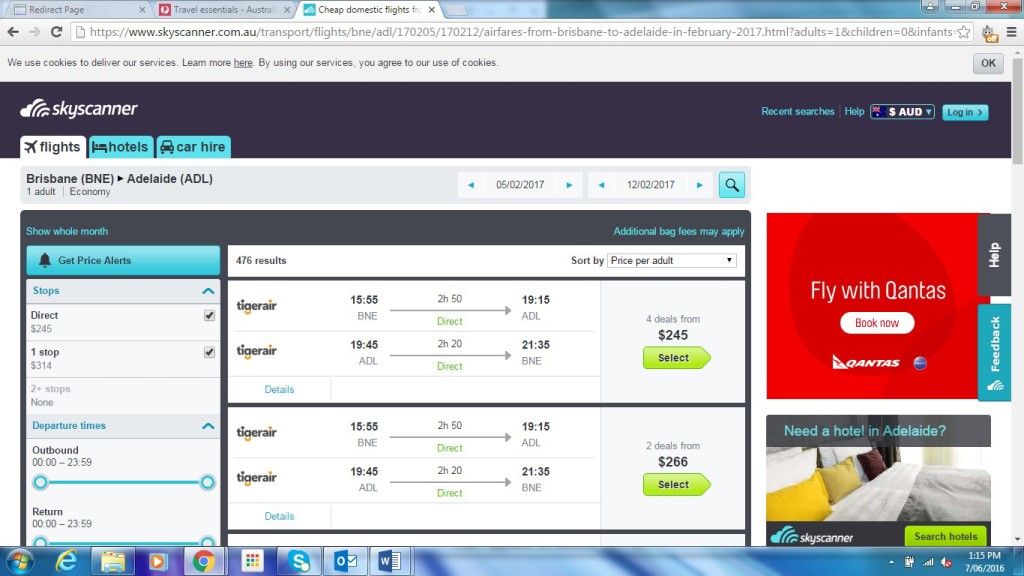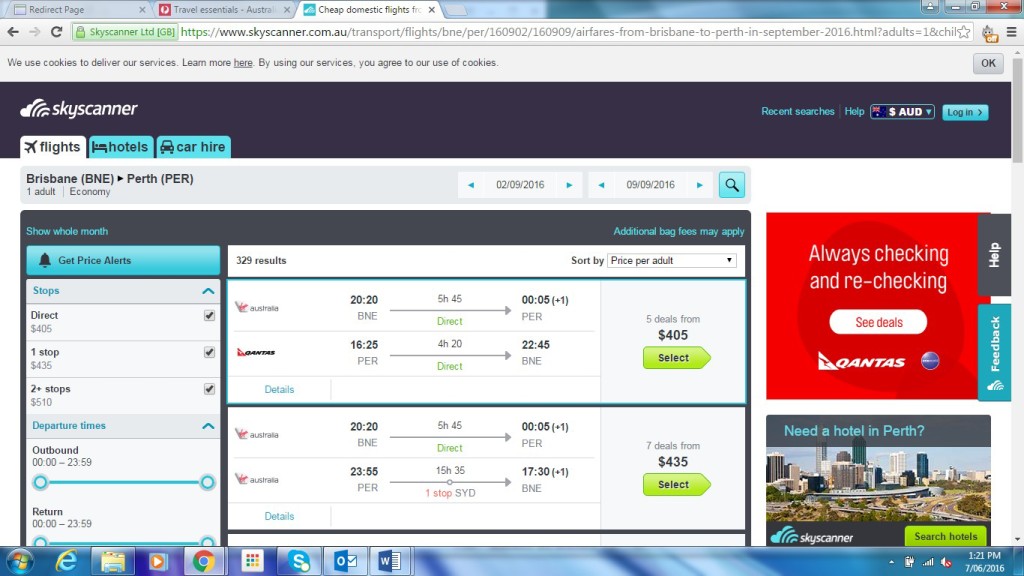You can view our 5 pages of written support material either by downloading this PDF: Story City – Support Material – Emily Craven – AusCo, or by viewing the material on the page below. The material included in this support package is:
1. Download links for the app, and instructions on how to use it at home.
2. Images of the current app
3. Breakdown of production schedule
4. Community engagement framework
5. Workshop breakdown
6. Screen grabs of flight costs
Images of App & Download Links
You can download and view the app on either Android or Apple devices. We did not provide a direct link to the app as it depends on what device you are using as to which version of the app will work for you. For iPhone users make sure you have iOS3 before downloading. The links are:
Apple: https://itunes.apple.com/WebObjects/MZStore.woa/wa/viewSoftware?id=972223741&mt=8
Android: https://play.google.com/store/apps/details?id=au.com.storycity.storycity
If you wish to sample previous stories:
1. Please go to the a�?Configa�� tab and turn off (the square is grey when turned off) the a�?Navigate by GPSa�� option.
2. From there select an adventure from the list tab.
3. Once you start an adventure, select the map button on the bottom and tap on the options in the map to be taken to the next part of the story without having to be in that location to unlock the story set there.
4. If you wish to stop the adventure and see what happened along a different path, press the centre a�?Stopa�� button at the bottom. Then just reopen the story, select start and follow the new path using the map and tap function described above.
Images of App
Image 1: Choices presented by the app for you to continue the story. Image 2: See what stories are available on the map near you. Image 3: A List of stories available and the distance from your current location to where they start.
Image 1: Story Description Page. Image 2: Splash screen for the App
Schedule
Emily & her producer Grant Mills, have been running these projects for three years now & have the schedule down to a smooth 6-month process for each city they run it in (we can concurrently run 4-8 projects/cities at a time). We plan to start the Canberra roll out in October 2016, Adelaide in January 2017, and Perth in April 2017. The roll-out for each city is specified below:
1. EOI for that city launched & open (4wks);
2. Participants selected and workshop run (1wk);
3. Selected writers/artists participate in on location walk (1wk after workshop);
4. Writers create stories which go through an editing process with producers (6wks);
5. Stories recorded & edited by voiceover narrator (2wks);
6. Stories illustrated & scored by artists/musician (6wks);
7. Stories are uploaded to theStory City app (2wks);
8. Stories are tested (1wk);
9. Stories for that city are launched a week later.
Community Engagement Framework
We engage the community on three fronts:
Artistic and storytelling community: While we set a story theme and curate the stories based on that theme, we leave the decision of what stories, location and history is important to the community who lives in and will be creating stories, for that city. It is by focusing on the stories that matter to the locals that we gain local support for not only the project, but the stories and the artists themselves. Ita��s local stories, by local artists, using local history, with international appeal. We then give 30 writers, artists and musicians the space to engage with cutting edge education, the project, and the stories the artists propose, via our day long Professional development workshop. During that workshop not only do we provide artists with training but, each story proposed gets worked on and expanded during an extended brainstorming exercise with a small break-out group of artists, encouraging projects to continue beyond the Story City project and framework.
National Writers Centres: Become a centre for engagement and collaboration during the project, with workshops being run on their premises, emerging artists introduced to their networks and services, writers filling and activating the spaces with residencies and the local community invited not only to launch the stories but to engage with these peak arts and culture institutions.
Local and International Community: The stories we create are interactive for a purpose, they allow the reader, whether they be a local or tourist, to make choices that affect and change the narrative and put them directly in the shoes of a character straight from Australian history. We avoid the passive experience and instead throw them in the deep end. Each story highlights local features, getting participants to engage and interact with place and public space as well as the history that permeates it. Participants are encouraged to add to the story via social media, photographs and videos. We know that by imparting this, often dry information, in engaging story format, that empathy and understanding for the ANZACs, whether they be young boys, women, immigrants fighting for a new country or indigenous soldiers fighting for a country that would rather forget them, becomes stronger and makes their association to place and history an experience they want to share.
Workshop PD Breakdown
Below is a breakdown of the segments we work through during the professional development workshop:
1. Introduction to Story City, how it works, influences, and related initiatives.
2. Locative Literature & Writing for Apps, how to create engaging transmedia and the a�?rulesa�� of transmedia.
3. What Types of a�?Adventuresa�� Can You Create? How to take advantage of the format, choose your adventures, puzzle trails, informational walks, and a discussion on the advantages of each.
4. The Basics of Creating interactive narrative, how to get your audience involved in the story, the roles of the collaborating artists, how you use location to your advantage and how do you structure your medium to create the story.
5. Crafting Your Beginnings, Your Choices, & Your Endings with a focus on reader motivations and the psychology of decision making.
6. Considerations for Artists, Narrators and Musicians, such as how to manage a successful collaboration, what information you need to provide your collaborator, and ideas generation.
7. Brainstorming of ideas, what works best in each medium, how you can move your ideas forward separate from Story City (includes case studies), networking and a�?hack-a-thonsa�� 101.
8. How to build an arts career that deviates from the traditional pathways to an audience (such as publishers, galleries, or gigging in pubs), and how to take advantage of the digital revolution with your arts practise.
Screen Grabs of Flight Costs
Flights between Brisbane (where producer is based) and Canberra, first for the workshop, then for the story testing in location:
Flights between Brisbane (where producer is based) and Adelaide, first for the workshop, then for the story testing in location:
Flights between Brisbane (where producer is based) and Perth, first for the workshop, then for the story testing in location:

